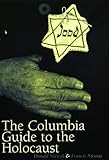The Columbia Guide to the Holocaust / Francis Nicosia, Donald Niewyk.
Material type: TextPublisher: New York, NY : Columbia University Press, [2003]Copyright date: ©2003Description: 1 online resource (416 p.) : 11 maps, tablesContent type:
TextPublisher: New York, NY : Columbia University Press, [2003]Copyright date: ©2003Description: 1 online resource (416 p.) : 11 maps, tablesContent type: - 9780231112017
- 9780231505901
- 940.53/18 21
- D804.3
- online - DeGruyter
- Issued also in print.
| Item type | Current library | Call number | URL | Status | Notes | Barcode | |
|---|---|---|---|---|---|---|---|
 eBook
eBook
|
Biblioteca "Angelicum" Pont. Univ. S.Tommaso d'Aquino Nuvola online | online - DeGruyter (Browse shelf(Opens below)) | Online access | Not for loan (Accesso limitato) | Accesso per gli utenti autorizzati / Access for authorized users | (dgr)9780231505901 |
Browsing Biblioteca "Angelicum" Pont. Univ. S.Tommaso d'Aquino shelves, Shelving location: Nuvola online Close shelf browser (Hides shelf browser)

|

|

|

|

|

|

|
||
| online - DeGruyter The Power and Limits of NGOs : A Critical Look at Building Democracy in Eastern Europe and Eurasia / | online - DeGruyter The Columbia Guide to American Environmental History / | online - DeGruyter Pursuing Privacy in Cold War America / | online - DeGruyter The Columbia Guide to the Holocaust / | online - DeGruyter Resiliency Enhancement : Putting the Strength Perspective Into Social Work Practice / | online - DeGruyter The Columbia Guide to Asian American History / | online - DeGruyter Thinking Teams / Thinking Clients : Knowledge-Based Team Work / |
Frontmatter -- CONTENTS -- Acknowledgments -- Introduction -- PART I . HISTORICAL OVERVIEW -- Historical Overview -- PART II . PROBLEMS AND INTERPRETATIONS -- Defining the Holocaust -- Roots of the Holocaust -- How the "Final Solution" Came About -- The Perpetrators and Their Motivations -- The Victims' Reactions to Persecution -- The Behavior of Bystanders -- The Question of Rescue -- The Lasting Effect of the Holocaust -- PART III. CHRONOLOGY -- Chronology -- PART IV. ENCYCLOPEDIA -- Encyclopedia -- PART V. RESOURCES -- Resources -- Printed Reference Works -- Printed Sources (Primary and Secondary) -- Filmography -- Electronic Resources -- Resource Organizations, Museums, and Memorials -- Appendix 1. Tables -- Appendix 2. Maps -- Index
restricted access online access with authorization star
http://purl.org/coar/access_right/c_16ec
Offering a multidimensional approach to one of the most important episodes of the twentieth century, The Columbia Guide to the Holocaust offers readers and researchers a general history of the Holocaust while delving into the core issues and debates in the study of the Holocaust today. Each of the book's five distinct parts stands on its own as valuable research aids; together, they constitute an integrated whole. Part I provides a narrative overview of the Holocaust, placing it within the larger context of Nazi Germany and World War II. Part II examines eight critical issues or controversies in the study of the Holocaust, including the following questions: Were the Jews the sole targets of Nazi genocide, or must other groups, such as homosexuals, the handicapped, Gypsies, and political dissenters, also be included? What are the historical roots of the Holocaust? How and why did the "Final Solution" come about? Why did bystanders extend or withhold aid? Part III consists of a concise chronology of major events and developments that took place surrounding the Holocaust, including the armistice ending World War I, the opening of the first major concentration camp at Dachau, Germany's invasion of Poland, the failed assassination attempt against Hitler, and the formation of Israel.Part IV contains short descriptive articles on more than two hundred key people, places, terms, and institutions central to a thorough understanding of the Holocaust. Entries include Adolf Eichmann, Anne Frank, the Warsaw Ghetto, Aryanization, the SS, Kristallnacht, and the Catholic Church. Part V presents an annotated guide to the best print, video, electronic, and institutional resources in English for further study.Armed with the tools contained in this volume, students or researchers investigating this vast and complicated topic will gain an informed understanding of one of the greatest tragedies in world history.
Issued also in print.
Mode of access: Internet via World Wide Web.
In English.
Description based on online resource; title from PDF title page (publisher's Web site, viewed 02. Mrz 2022)


